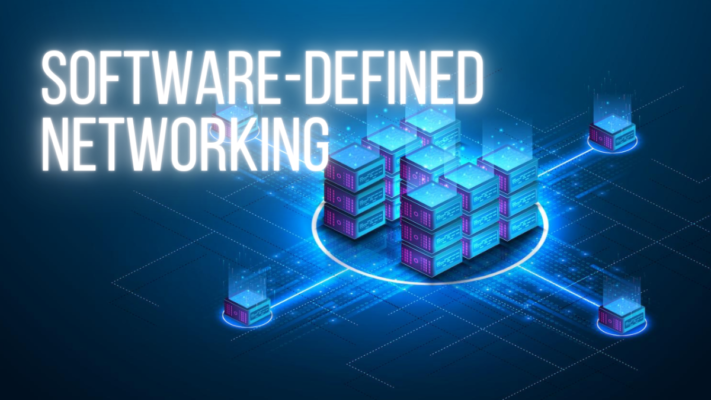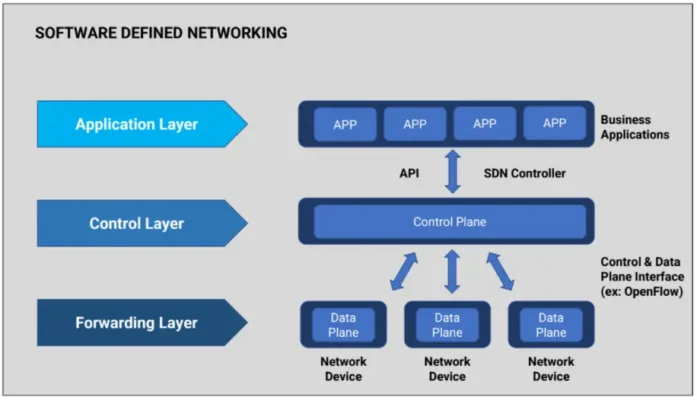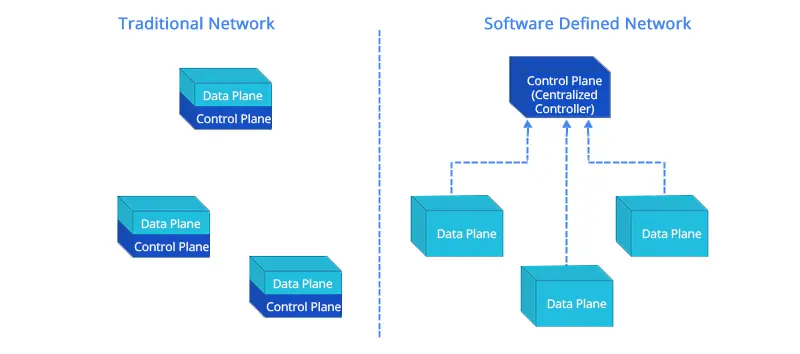Traditional networks often struggle with complexity and rigidity. Making changes can be slow and error-prone. SDN comes to the rescue with these limitations. This guide explores what SDN is, covering exactly how it works, its architecture and core components, the significant benefits it brings, and the challenges you may encounter.
What is a Software-Defined Networking (SDN)?
Software-Defined Networking (SDN) is a network architecture approach that separates the network’s control plane (the intelligence or “brain”) from its data plane (the hardware that forwards traffic or “muscle”).
This separation allows network control to be directly programmable and centrally managed by software applications, specifically the SDN Controller. Essentially, SDN makes the network more agile, flexible, and automated compared to traditional networks where control logic is tightly integrated within individual hardware devices.

How does SDN works?
The process of handling network traffic in SDN follows a logical flow, orchestrated by the controller. It begins when an application or service needs to communicate across the network and ends with packets flowing according to centrally defined policies and paths efficiently.
- Application Request: An application (like a video conferencing tool or a database) communicates its network requirements (e.g., bandwidth needs, latency sensitivity) to the SDN Controller. This communication happens via the controller’s Northbound Application Programming Interfaces (APIs).
- Controller Processing: The SDN Controller receives this request. It consults its real-time view of the entire network topology (which links are up, device capabilities, current traffic load). It then considers pre-defined network policies and calculates the best path for the application’s traffic.
- Flow Programming: The controller translates its decision into specific forwarding instructions, often called “flow rules.” These rules tell the network devices exactly how to handle packets belonging to that specific application’s traffic flow (e.g., forward packets matching criteria X out of port Y).
- Southbound Communication: Using Southbound APIs (like the OpenFlow protocol), the controller pushes these flow rules down to the relevant switches and routers along the calculated path. These devices reside in the infrastructure layer, also known as the data plane.
- Data Plane Forwarding: The network devices receive these instructions and update their internal “flow tables.” When data packets matching these rules arrive, the devices instantly forward them according to the controller’s instructions without needing further consultation for each packet (proactive forwarding).
- Handling Unknown Flows: Sometimes, a packet arrives at a switch that doesn’t match any existing flow rule. The switch can be configured to send this packet (or just its header information) up to the controller (reactive forwarding). The controller then analyzes it, decides on the appropriate action, potentially installs a new flow rule, and instructs the switch.
- Monitoring & Adaptation: The SDN Controller continuously monitors the network’s health and performance, collecting statistics from devices. If conditions change (e.g., a link fails, congestion occurs), the controller can dynamically recalculate paths and update flow rules automatically to maintain performance and resilience.

Key Benefits of Implementing SDN
Adopting Software-Defined Networking brings numerous advantages over traditional network architectures. These benefits translate into a more agile, efficient, secure, and cost-effective network infrastructure capable of supporting modern digital transformation initiatives and rapidly evolving business application requirements across various industries.
- Centralized Network Management and Visibility: SDN provides a single pane of glass for managing the entire network. Administrators gain a holistic view, simplifying configuration, monitoring, policy enforcement, and troubleshooting efforts across potentially thousands of distributed network devices significantly.
- Increased Agility and Flexibility: Networks become highly adaptable. Changes like provisioning new services, implementing security policies, or adjusting traffic paths can be made quickly through software, often in minutes instead of days or weeks, accelerating business responsiveness and application deployment cycles.
- Network Automation and Orchestration: SDN is a key enabler for network automation. Repetitive tasks like device configuration, policy updates, and compliance checks can be automated through the controller’s APIs, reducing manual errors, freeing up IT staff for strategic tasks, and ensuring consistency.
- Potential for Reduced Costs: Automation significantly reduces OpEx associated with manual labor. Furthermore, SDN can enable the use of less expensive, commodity “white-box” hardware instead of proprietary systems, potentially lowering CapEx and mitigating vendor lock-in effects over time. Industry observations often point towards significant TCO reductions.
- Enhanced Network Security: Centralized control allows for consistent, network-wide security policy deployment. SDN facilitates techniques like micro-segmentation (isolating workloads with fine-grained policies) and enables rapid, automated responses to threats, such as automatically quarantining infected devices detected by security tools integrated via Northbound APIs.
- Improved Network Performance and Resource Optimization: With its global view, the SDN controller can make intelligent traffic engineering decisions, optimizing paths based on real-time conditions, balancing loads effectively, and ensuring efficient utilization of network bandwidth and resources, leading to better application performance.
- Faster Service Deployment and Innovation: The programmable nature of SDN provides a platform for innovation. New network services and applications can be developed and deployed much faster, leveraging the controller’s APIs without being constrained by the limitations of underlying hardware capabilities or complex manual configurations.
- Reduced Vendor Lock-in: Especially when utilizing open standards like OpenFlow (Open SDN approach), organizations gain more flexibility in choosing hardware vendors. This promotes competition, potentially lowers costs, and allows for best-of-breed solutions rather than being tied to a single vendor’s ecosystem completely.
SDN vs. Traditional Networking: Key Differences
The core difference lies in the architecture and control methodology. Traditional networking integrates control logic within each hardware device, leading to distributed management. SDN decouples this control, centralizing it in software for greater programmability and a holistic network view.
| Feature | Traditional Networking | Software-Defined Networking (SDN) |
|---|---|---|
| Control Plane | Distributed, integrated in each device | Centralized (logically), decoupled from data plane |
| Data Plane | Integrated with control plane | Decoupled, follows controller instructions |
| Management | Device-by-device, often manual (CLI) | Centralized, policy-driven, automatable |
| Configuration | Static, manual | Dynamic, programmable |
| Hardware | Often proprietary, vendor-specific | Can leverage commodity hardware, open standards |
| Flexibility | Lower | Higher |
| Automation | Limited | High potential |
| Intelligence | Distributed across devices | Centralized in controller |
| View | Local device view | Global network view |

SDN and Network Function Virtualization (NFV)
SDN and Network Function Virtualization (NFV) are often discussed together, but they address different aspects of network transformation. They are distinct yet highly complementary, often deployed in tandem to create truly agile and software-driven network infrastructures for modern demands.
NFV focuses on what provides network services. It virtualizes entire classes of network functions – like firewalls, load balancers, routers, or WAN accelerators – allowing them to run as software applications (Virtual Network Functions or VNFs) on standard, off-the-shelf server hardware, storage, and switches (NFV Infrastructure or NFVI). This decouples network functions from specialized, expensive hardware appliances.
SDN, conversely, focuses on how the network infrastructure itself is controlled and how traffic is steered between endpoints and services. It provides the programmable connectivity fabric. When used together, NFV provides the agile, software-based network services, while SDN provides the intelligent, automated network pathways to connect users to those services and interconnect the VNFs themselves dynamically.
For example, NFV might provide a virtual firewall VNF, while SDN dynamically routes specific traffic flows through that VNF based on security policies managed centrally by the SDN controller. This synergy enables rapid service chaining, scaling, and deployment flexibility far beyond traditional hardware-based approaches.
Types of SDN
The term SDN encompasses several approaches and implementation models. While the core principle of separating control and data planes remains consistent, the specific methods, protocols, and level of openness can vary depending on the chosen architecture and vendor strategy employed.
Open SDN
This approach emphasizes the use of open standards, primarily the OpenFlow protocol, for communication between the SDN controller and the network devices (Southbound API). The goal is maximum interoperability and vendor neutrality, allowing organizations to mix and match hardware and software components freely.
Open SDN
Characteristic: This type strictly adheres to open standards, most notably using the OpenFlow protocol for the Southbound API communication between the controller and network devices.
Goal: Promotes vendor neutrality and interoperability, allowing organizations to mix hardware and software from different vendors.
API-Based SDN (Controller-Based or Proprietary SDN)
Characteristic: Relies on Application Programming Interfaces (APIs) – often RESTful APIs – exposed by the SDN controller (Northbound) or sometimes directly by network devices (Southbound), which may be proprietary to a specific vendor. OpenFlow might still be used underneath, but the primary control/interaction point is the API.
Goal: Often provides tighter integration within a specific vendor’s ecosystem, potentially offering unique features accessible via their APIs.
Overlay SDN
Characteristic: Creates one or more virtual networks (overlay networks) on top of an existing physical network (underlay network) using tunneling protocols like VXLAN or GENEVE. The SDN controller manages these virtual overlays, programming virtual switches often running in hypervisors or on physical devices. The underlay network might be traditional or SDN-controlled itself.
Goal: Provides network segmentation, flexibility, and agility without needing to make significant changes to the underlying physical infrastructure. Commonly used in data centers and cloud environments. SD-WAN solutions also heavily utilize overlay principles.
Hybrid SDN
Characteristic: Combines SDN principles with traditional networking within the same environment. Certain parts of the network are managed by an SDN controller, while other parts continue to operate using traditional distributed control plane protocols.
Goal: Allows for gradual migration to SDN, targeting specific network segments for modernization while maintaining existing operations elsewhere. Provides flexibility during transition phases.
SDN Implementation Best Practices
Successfully implementing SDN requires more than just technology deployment; it involves strategic planning, organizational readiness, and a focus on operational integration. Following best practices can help organizations navigate the transition smoothly and realize the full potential benefits of SDN effectively.
- Assess Needs and Readiness: Before diving in, evaluate your current network’s pain points. Understand your business goals for SDN (e.g., agility, cost savings, automation). Assess your existing infrastructure’s compatibility and your IT team’s current skill set regarding programming and automation needs.
- Develop a Phased Strategy: Avoid a “big bang” approach. Define clear objectives, scope, and a realistic timeline. Start with a pilot project in a controlled environment (like a lab, a specific data center pod, or SD-WAN for a few branches) to gain experience and demonstrate value before wider rollout.
- Choose Technologies and Vendors Wisely: Research different SDN controllers, protocols, and hardware options. Consider factors like scalability, reliability, features, support, adherence to open standards (if desired), and compatibility with your existing environment. Conduct proof-of-concept (PoC) testing if possible.
- Focus on Interoperability and Standards: If using multiple vendors or aiming for flexibility, prioritize solutions that adhere to open standards like OpenFlow or use well-documented APIs. This helps avoid vendor lock-in and simplifies integration between different components of the SDN ecosystem significantly.
- Invest in Team Training and Skills Development: SDN requires new skills. Provide training for your network engineers on SDN concepts, controller platforms, relevant programming languages (like Python), automation frameworks, and API usage. Foster a culture of continuous learning to keep pace with technology evolution.
- Prioritize Security from the Start: Integrate security considerations into your SDN design from day one. Secure the controller, protect Northbound and Southbound APIs, implement robust authentication and authorization, and leverage SDN’s capabilities for micro-segmentation and automated threat response effectively across the infrastructure.
- Implement Monitoring and Management Tools: Deploy tools that provide visibility into the SDN environment’s performance and health. Leverage the controller’s analytics capabilities. Establish processes for monitoring, troubleshooting, and managing the SDN infrastructure proactively to ensure optimal operation and minimize potential downtime effectively.
Challenges and Considerations for SDN Adoption
While SDN offers compelling benefits, organizations considering adoption must also be aware of potential challenges and plan accordingly. Addressing these considerations proactively is key to a successful implementation and maximizing the return on investment from this networking paradigm shift effectively.
- Security Concerns: The centralized controller, while enabling unified management, also represents a critical potential point of failure and a high-value target for attackers. Distributed Denial of Service (DDoS) attacks against the controller or compromised Northbound/Southbound communications can disrupt the entire network. Robust controller security and API protection are paramount.
- Scalability Issues: A single, centralized controller might struggle to manage extremely large or highly dynamic networks, potentially becoming a performance bottleneck. Distributed controller architectures exist to improve scalability and resilience but introduce their own complexities in coordination and consistency management across multiple instances. Flow table capacity on data plane devices can also impose limits.
- Complexity: SDN introduces a new layer of abstraction and different management paradigms. While simplifying some tasks, it requires understanding controllers, APIs, potential software bugs, and troubleshooting interactions between software layers and hardware, which can be complex initially compared to traditional device-centric approaches.
- Interoperability Between Vendors/Components: Despite standards like OpenFlow, ensuring seamless interoperability between controllers, applications, and network devices from different vendors can still be challenging. Variations in implementation quality, support for specific features, and proprietary extensions require careful testing and validation in multi-vendor environments.
- Reliability and Redundancy Planning: The network’s reliance on the SDN controller necessitates robust redundancy strategies. Controller clustering, failover mechanisms, and ensuring reliable communication paths between controllers and devices are critical design considerations to prevent outages if a controller instance fails unexpectedly.
- Skills Gap: Managing an SDN environment requires skillsets beyond traditional network engineering. Proficiency in programming (e.g., Python), automation tools, and working with APIs becomes essential. Organizations need to invest in training existing staff or hiring new talent with these software-oriented skills.
- Migration Strategy from Traditional Networks: Transitioning from an established traditional network to SDN typically requires careful planning. A phased approach, often starting with specific areas like the data center or a new branch (using SD-WAN), or implementing hybrid models, is usually recommended over a disruptive “rip and replace” strategy.
Frequently Asked Questions (FAQ) about SDN
- Q1: Is SDN hardware or software? SDN is primarily a software-based architecture that changes how network hardware is controlled. While it utilizes physical switches and routers (hardware), the intelligence and control logic reside in centralized software (the SDN Controller), making the network programmable via software interfaces.
- Q2: What is the main difference between SDN and NFV? SDN separates the network’s control plane (decision-making) from the data plane (forwarding). NFV (Network Function Virtualization) separates network functions (like firewalls, load balancers) from dedicated hardware appliances, allowing them to run as software (VNFs) on standard servers. They are complementary.
- Q3: What is an SDN controller? An SDN controller is the central software application acting as the “brain” of an SDN network. It maintains a view of the network topology, makes decisions about traffic flow, translates application requests into device instructions, and pushes policies down to the network hardware via Southbound APIs.
